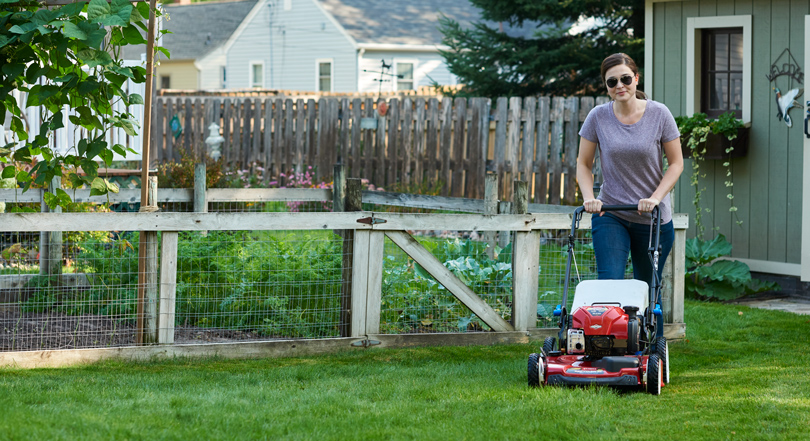
The peak of summer heat is here – can your lawn handle it?
We suggest the following tips and tricks in order to maintain a healthy, intact lawn during the extreme heat of the summer.
Tip #1: Refrain From Cutting Grass Too Short
One common mistake made by both homeowners and commercial landscape maintenance companies is cutting a lawn too short. If a lawn is cut too short, it reduces the plants’ ability to produce energy for growth. When cut at the proper height, however, grass develops stronger roots that support more vigorous plants that are more tolerant of stress.
Keep in mind that different varieties of grass have different growth habits that directly relate to mowing heights. For example, cool-season grass and warm season grass types require somewhat different maintenance techniques and recommended cutting heights.
Tip #2: Remember the One-Third Rule
When deciding on the correct height to cut your grass, it is important to also remember the “one-third” rule: never remove more than one-third of the grass height at one time. By doing so, the lawn is kept cooler because less plant tissue is removed.
In fact, cool season grass types actually benefit in the heat of the summer by setting the blade higher. If a lawn is normally cut at 2.5 inches, for example, increasing it to 3 inches in the heat of summer will come with many benefits.
Tip #3: Limit Water Intake
One collective misconception about maintaining grass in extreme heat is the necessity to over water. A glaring issue is that after rainfall, people still irrigate their lawn. A general rule to keep in mind is that turf grasses do better managed on the dry side rather than wet; when soil is constantly wet, it creates too many physiological problems for plants and soil organisms alike. The grass roots will be deprived of oxygen and may become more susceptible to disease because diseases thrive in wet conditions. In general, the drier the grass and soil, the less disease there will be.
Another rule-of-thumb is to water “deeply and infrequently.” Water deeply to wet the entire root zone, and then do not water again until the grass is dry. To determine next watering time, simply “eye-it.” If it starts to look dry, then water. If you would like to be specific, water the hot spots (spots that get dry faster than the rest of the lawn) and then wait for the rest of the lawn to dry out.
While it is important to be adequate on hydration, do not water the grass daily. Lawns need only one-inch of water per week, including rainfall.
Tip #4: When in Drought
Avoid mowing the lawn during drought stress. Lawns under such stress are limited in their ability to recover from mowing and can be damaged even more. Instead, mow the grass after a rainfall or after irrigation day. Also, resist mowing wet grass to avoid clumping.
Tip #5: Keep Blades Sharp
When grass is cut with a sharp mower blade, the plant will heal faster than when cutting with a dull blade. Dull blades will actually tear the plant tissue, not cut it; this torn grass tissue will develop a brown appearance at the surface and may become more susceptible to stress and disease. Sharper blades will prevent a brown appearance and help to prevent further harm to the plant.
Tip #6: Do Not Bag Grass Clippings
Return clippings to the lawn by using a mulching mower. Clippings are actually beneficial to the lawn, as they act as a slow-release fertilizer for the plant as they decompose. It is important to aim the clippings away from streets, storm drains, and bodies of water.
When near bodies of water, do bag the clippings within one or two mower widths of the water’s edge to reduce pollution of streams and lakes from the nutrients released from decomposing leaf tissue.
Tip #7: Fertilizing and Cultivation? Don’t Even Think About It
Homeowners and landscape companies alike will do what it takes to keep their lawn healthy and growing right. Although the idea of fertilizing might sound like a good idea to maintain a vigorous lawn, do not consider it during the heat of mid-summer. During the hot summer months, the cool season grasses are consuming more than they can produce. Fertilizing stimulates more growth, which consumes even more energy further stressing lawns during periods of high temperatures.
The same rules apply to cultivation practices such as aerification and dethatching. Resist aggressive practices that impose temporary damage during periods of summer heat. Instead, cultivate in fall or spring when the turf is vigorous and can recover quickly from the temporary injury.
Tip #8: Importance of Year-Round Health
An overall two-pronged approach will make maintaining a healthy lawn an easier process. Step one is to maintain year-round health. Grass will tolerate the heat more easily if it is in a healthy state throughout the entire year. Season-long care includes proper fertilization, watering, mowing, and pest control that all help to produce a consistently healthy lawn that is best able to tolerate summer (and other) stresses. In terms of your own health, think of step one as eating right, regular exercise and good sleep to ensure your best long-term health.
Step two of the two-pronged approach is to use best management practices during the actual summer stress period – all the things discussed in this article above. Again, in terms of your own health, step two is analogous to the things your doctor prescribes when you are sick to get well in the short-term.
